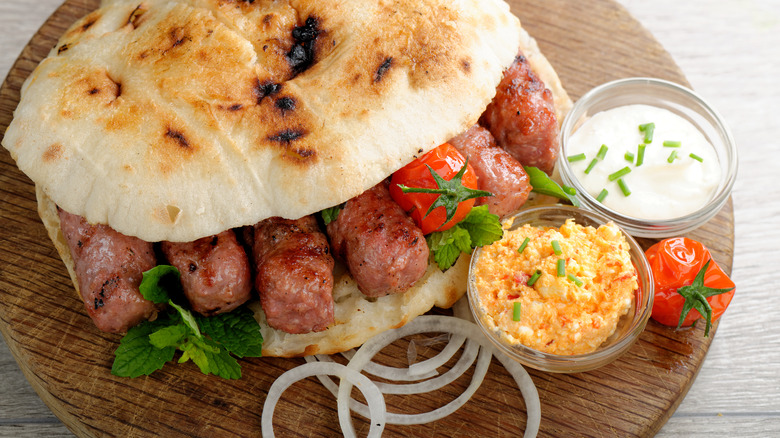The Key Toppings That Make Up A Traditional Cevapi Sandwich
Whether it's tacos in Mexico, doner kebabs in Turkey, or banh mi in Vietnam, every country has a treasured handheld street food staple. In the Balkans, the go-to sandwich is cevapi, a cross between a kebab and a kofta. The Serbian word for kebab, cevapi are hand-formed sausages made with ground beef, lamb, and pork meat. They're seasoned with salt, pepper, and often paprika. Then, baking soda is added, and the sausages left in the fridge overnight before being thrown on the grill the next day. The baking soda and overnight rest result in an especially tender and flavorful bite. Cevapi is popular in most Balkan countries and Western European nations like Austria, Italy, and Germany. It's also considered the national dish of Serbia, Bosnia and Herzegovina, and Romania.
Depending on the country, the recipe might call for different types of meat or aromatic additions, but you can always count on two toppings to remain the same: raw onions and ajvar. Whether you get the dish served as a plate or in a traditional Balkan flatbread, ajvar and onions always come with it. Ajvar is a Serbian-born condiment made with roasted red peppers, eggplant, olive oil, salt, and pepper. With a well-rounded profile of smoky, earthy, spicy, and sweet flavors, ajvar is an all-in-one garnish to compliment the savoriness of cevapi. Iterations of the condiment also include vinegar, garlic, onions, cooked carrots, and tomatoes.
Variations on cevapi and sandwich garnishes
The traditional recipe for cevapi originated in Belgrade, Serbia, in 1860 as an adaptation of the Serbian hamburger known as pljeskavica. Coincidentally, the Serbian restaurant owner who invented the dish was from Leskovac, the same region that founded ajvar. Since Serbia is a Christian nation, the original recipe included pork. However, as cevapi spread to Muslim nations, such as Bosnia and Herzegovina, the recipe excluded pork and became a mixture of mutton, lamb, beef, and veal. Romanian recipes use a mixture of baking soda and beer to tenderize beef and pork cevapi, seasoning them with garlic and a wealth of herbs and spices. Croatian cevapi features three kinds of paprika, bread crumbs, onions, and garlic.
Flatbreads in the Balkans are round, pita-shaped varieties that are thicker and spongier than Middle Eastern or Greek pitas. Serbian lepinja looks like a cross between pita and focaccia bread. In addition to ajvar and onion garnishes, a condiment known as kajmak, a sour version of clotted cream, is one of the most popular cevapi sandwich accompaniments in many Baltic countries and Turkey. Other garnishes include sour cream, feta cheese, a creamy cabbage salad, or shopska (a Baltic variation of Greek or Israeli salad).

